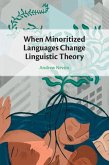Morphological Diversity and Linguistic Cognition
Herausgeber: Sims, Andrea D.; Parker, Jeff; Ussishkin, Adam
Morphological Diversity and Linguistic Cognition
Herausgeber: Sims, Andrea D.; Parker, Jeff; Ussishkin, Adam
- Broschiertes Buch
- Merkliste
- Auf die Merkliste
- Bewerten Bewerten
- Teilen
- Produkt teilen
- Produkterinnerung
- Produkterinnerung
Bringing together a team of well-known scholars, this volume explores the relationship between factors influencing how language is processed in the mind and the range of different types of word structures found across languages of the world. It is aimed at linguists, particularly morphologists and typologists, and cognitive scientists.
Andere Kunden interessierten sich auch für
![When Minoritized Languages Change Linguistic Theory When Minoritized Languages Change Linguistic Theory]() Andrew Nevins (University College London and Universidade Federal dWhen Minoritized Languages Change Linguistic Theory31,99 €
Andrew Nevins (University College London and Universidade Federal dWhen Minoritized Languages Change Linguistic Theory31,99 €![When Minoritized Languages Change Linguistic Theory When Minoritized Languages Change Linguistic Theory]() Andrew Nevins (University College London and Universidade Federal dWhen Minoritized Languages Change Linguistic Theory108,99 €
Andrew Nevins (University College London and Universidade Federal dWhen Minoritized Languages Change Linguistic Theory108,99 €![Linguistic Knowledge and Language Use Linguistic Knowledge and Language Use]() Benoit Leclercq (Universite Paris 8)Linguistic Knowledge and Language Use114,99 €
Benoit Leclercq (Universite Paris 8)Linguistic Knowledge and Language Use114,99 €![Morphological Complexity Morphological Complexity]() Matthew Baerman (University of Surrey)Morphological Complexity30,99 €
Matthew Baerman (University of Surrey)Morphological Complexity30,99 €![Morphological Complexity Morphological Complexity]() Matthew Baerman (University of Surrey)Morphological Complexity128,99 €
Matthew Baerman (University of Surrey)Morphological Complexity128,99 €![Cognitive Linguistic Approaches to Text and Discourse Cognitive Linguistic Approaches to Text and Discourse]() Cognitive Linguistic Approaches to Text and Discourse31,99 €
Cognitive Linguistic Approaches to Text and Discourse31,99 €![Teaching for Linguistic Diversity in Schools Teaching for Linguistic Diversity in Schools]() Robyn Moloney (Sydney Macquarie University)Teaching for Linguistic Diversity in Schools58,99 €
Robyn Moloney (Sydney Macquarie University)Teaching for Linguistic Diversity in Schools58,99 €-
-
-
Bringing together a team of well-known scholars, this volume explores the relationship between factors influencing how language is processed in the mind and the range of different types of word structures found across languages of the world. It is aimed at linguists, particularly morphologists and typologists, and cognitive scientists.
Produktdetails
- Produktdetails
- Verlag: Cambridge University Press
- Seitenzahl: 374
- Erscheinungstermin: 13. März 2025
- Englisch
- Abmessung: 229mm x 152mm x 20mm
- Gewicht: 542g
- ISBN-13: 9781108790949
- ISBN-10: 1108790941
- Artikelnr.: 72488868
- Herstellerkennzeichnung
- Libri GmbH
- Europaallee 1
- 36244 Bad Hersfeld
- gpsr@libri.de
- Verlag: Cambridge University Press
- Seitenzahl: 374
- Erscheinungstermin: 13. März 2025
- Englisch
- Abmessung: 229mm x 152mm x 20mm
- Gewicht: 542g
- ISBN-13: 9781108790949
- ISBN-10: 1108790941
- Artikelnr.: 72488868
- Herstellerkennzeichnung
- Libri GmbH
- Europaallee 1
- 36244 Bad Hersfeld
- gpsr@libri.de
1. At the intersection of cognitive processes and linguistic diversity
Andrea D. Sims, Adam Ussishkin, Jeff Parker and Samantha Wray; Part I. In
What Ways Is Language Processing Tuned to the Morphological Structure of a
Language?: 2. Tuning language processing mechanisms to a language's
morphology without decomposition: The case of semantic transparency Laurie
Beth Feldman and Fermín Moscoso del Prado Martín; 3. Productivity effects
on morphological processing in Maltese auditory word recognition Samantha
Wray and Adam Ussishkin; 4. Phonotactic and morphological effects in the
acceptability of pseudowords Jeremy M. Needle, Janet B. Pierrehumbert and
Jennifer B. Hay; Part II. What ROLE DOES CUE INFORMATIVITY PLAY IN LEARNING
AND HOW THE LEXICON EVOLVES OVER TIME?: 5. How agglutinative? Searching for
cues to meaning in Choguita Rarámuri (Tarahumara) using discriminative
learning Gabriela Caballero and Vsevolod Kapatsinski; 6. Words,
probability, and segmental information: Less probable words have more
informative segments Adam King and Andrew Wedel; 7. Learning complex
morphological patterns: The role of syncretism and markedness Sara Finley;
Part III. How Do System-Level Principles of Morphological Organization
Emerge?: 8. Morphology gets more and more complex, unless it doesn't Eric
Meinhardt, Robert Malouf and Farrell Ackerman; 9. Network structure and
inflection class predictability: Modeling the emergence of marginal
detraction Jeff Parker, Robert Reynolds and Andrea D. Sims; 10. Rule
combination, potentiation, affix telescoping Gregory Stump.
Andrea D. Sims, Adam Ussishkin, Jeff Parker and Samantha Wray; Part I. In
What Ways Is Language Processing Tuned to the Morphological Structure of a
Language?: 2. Tuning language processing mechanisms to a language's
morphology without decomposition: The case of semantic transparency Laurie
Beth Feldman and Fermín Moscoso del Prado Martín; 3. Productivity effects
on morphological processing in Maltese auditory word recognition Samantha
Wray and Adam Ussishkin; 4. Phonotactic and morphological effects in the
acceptability of pseudowords Jeremy M. Needle, Janet B. Pierrehumbert and
Jennifer B. Hay; Part II. What ROLE DOES CUE INFORMATIVITY PLAY IN LEARNING
AND HOW THE LEXICON EVOLVES OVER TIME?: 5. How agglutinative? Searching for
cues to meaning in Choguita Rarámuri (Tarahumara) using discriminative
learning Gabriela Caballero and Vsevolod Kapatsinski; 6. Words,
probability, and segmental information: Less probable words have more
informative segments Adam King and Andrew Wedel; 7. Learning complex
morphological patterns: The role of syncretism and markedness Sara Finley;
Part III. How Do System-Level Principles of Morphological Organization
Emerge?: 8. Morphology gets more and more complex, unless it doesn't Eric
Meinhardt, Robert Malouf and Farrell Ackerman; 9. Network structure and
inflection class predictability: Modeling the emergence of marginal
detraction Jeff Parker, Robert Reynolds and Andrea D. Sims; 10. Rule
combination, potentiation, affix telescoping Gregory Stump.
1. At the intersection of cognitive processes and linguistic diversity
Andrea D. Sims, Adam Ussishkin, Jeff Parker and Samantha Wray; Part I. In
What Ways Is Language Processing Tuned to the Morphological Structure of a
Language?: 2. Tuning language processing mechanisms to a language's
morphology without decomposition: The case of semantic transparency Laurie
Beth Feldman and Fermín Moscoso del Prado Martín; 3. Productivity effects
on morphological processing in Maltese auditory word recognition Samantha
Wray and Adam Ussishkin; 4. Phonotactic and morphological effects in the
acceptability of pseudowords Jeremy M. Needle, Janet B. Pierrehumbert and
Jennifer B. Hay; Part II. What ROLE DOES CUE INFORMATIVITY PLAY IN LEARNING
AND HOW THE LEXICON EVOLVES OVER TIME?: 5. How agglutinative? Searching for
cues to meaning in Choguita Rarámuri (Tarahumara) using discriminative
learning Gabriela Caballero and Vsevolod Kapatsinski; 6. Words,
probability, and segmental information: Less probable words have more
informative segments Adam King and Andrew Wedel; 7. Learning complex
morphological patterns: The role of syncretism and markedness Sara Finley;
Part III. How Do System-Level Principles of Morphological Organization
Emerge?: 8. Morphology gets more and more complex, unless it doesn't Eric
Meinhardt, Robert Malouf and Farrell Ackerman; 9. Network structure and
inflection class predictability: Modeling the emergence of marginal
detraction Jeff Parker, Robert Reynolds and Andrea D. Sims; 10. Rule
combination, potentiation, affix telescoping Gregory Stump.
Andrea D. Sims, Adam Ussishkin, Jeff Parker and Samantha Wray; Part I. In
What Ways Is Language Processing Tuned to the Morphological Structure of a
Language?: 2. Tuning language processing mechanisms to a language's
morphology without decomposition: The case of semantic transparency Laurie
Beth Feldman and Fermín Moscoso del Prado Martín; 3. Productivity effects
on morphological processing in Maltese auditory word recognition Samantha
Wray and Adam Ussishkin; 4. Phonotactic and morphological effects in the
acceptability of pseudowords Jeremy M. Needle, Janet B. Pierrehumbert and
Jennifer B. Hay; Part II. What ROLE DOES CUE INFORMATIVITY PLAY IN LEARNING
AND HOW THE LEXICON EVOLVES OVER TIME?: 5. How agglutinative? Searching for
cues to meaning in Choguita Rarámuri (Tarahumara) using discriminative
learning Gabriela Caballero and Vsevolod Kapatsinski; 6. Words,
probability, and segmental information: Less probable words have more
informative segments Adam King and Andrew Wedel; 7. Learning complex
morphological patterns: The role of syncretism and markedness Sara Finley;
Part III. How Do System-Level Principles of Morphological Organization
Emerge?: 8. Morphology gets more and more complex, unless it doesn't Eric
Meinhardt, Robert Malouf and Farrell Ackerman; 9. Network structure and
inflection class predictability: Modeling the emergence of marginal
detraction Jeff Parker, Robert Reynolds and Andrea D. Sims; 10. Rule
combination, potentiation, affix telescoping Gregory Stump.









